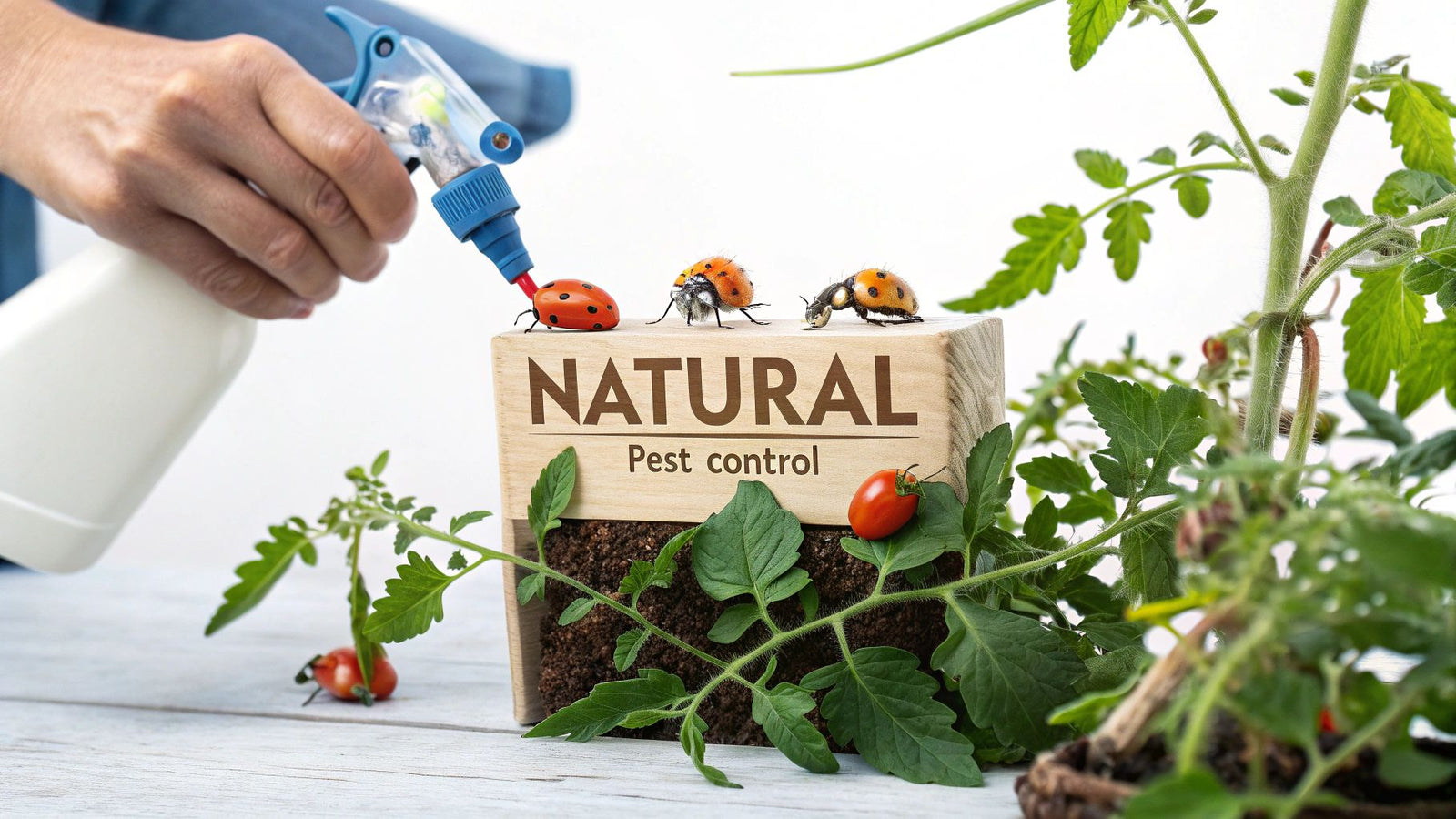
It's a sinking feeling, isn't it? You've poured your heart into nurturing your plants, only to find them under attack from pests. But before you reach for a chemical spray, let's talk about a better way. The most effective natural pest control for plants isn't about finding a magic bullet; it's about cultivating a healthy, balanced garden ecosystem where nature does most of the heavy lifting for you. This is about building long-term resilience, not just finding a quick—and often harmful—fix.
Why Choose Natural Pest Control for Your Garden
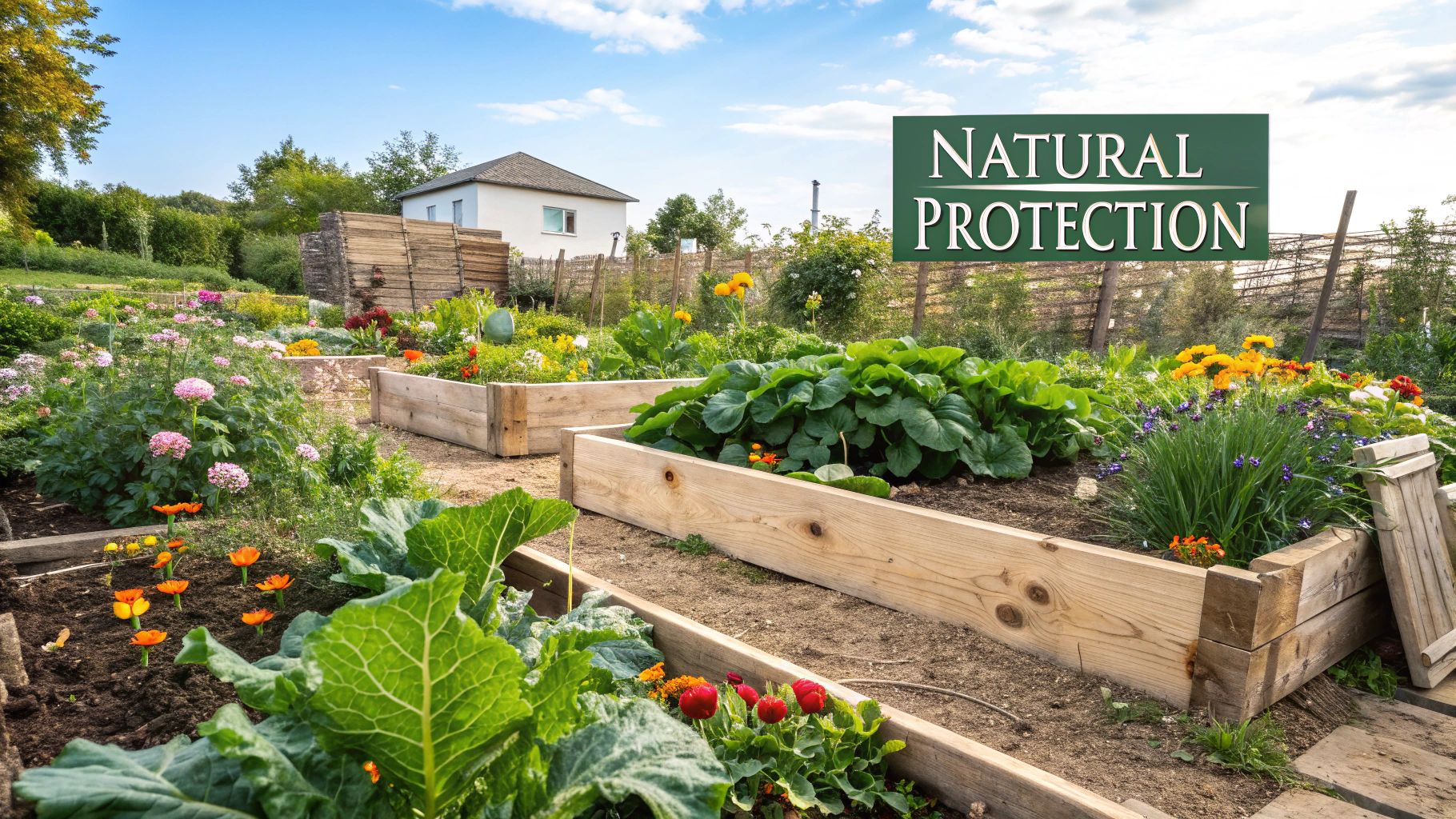
Let’s be real. Spotting holes chewed into your kale leaves or a cluster of aphids on your prize roses can feel like a personal insult. The gut reaction for many of us is to find the strongest stuff we can to wipe them out, right now. The problem is, that approach often creates more problems down the line, trapping you in a cycle of chemical dependency.
Choosing natural pest control means shifting your perspective. It’s about working with nature instead of constantly fighting against it.
A few nibbled leaves aren't a sign of failure. In fact, I like to think of it as proof that you're growing something so healthy and delicious that even the bugs can't resist! The idea of a completely sterile, pest-free garden is not only unrealistic but often unhealthy for the garden itself.
More and more gardeners are coming around to this way of thinking. You can see it in the numbers: the market for organic pest control was valued at USD 3.50 billion in 2024 and is expected to more than double to USD 8.20 billion by 2033. This isn't just a niche trend; it's a major shift toward safer, more sustainable practices in our backyards.
3 Key Benefits of a Natural Approach
When you embrace natural methods, the rewards go way beyond just getting rid of a few bugs. You're actually investing in a stronger, more self-sufficient garden for the long haul.
Instead of just reacting with a spray, you learn to build an environment that’s less attractive to pests and far more welcoming to their natural enemies. This is the heart of what’s known as Integrated Pest Management (IPM), and frankly, it's just a smarter way to garden.
Here’s what you stand to gain:
- Healthier Soil and Plants: Natural methods don't nuke the good guys. They protect the complex web of beneficial microbes, fungi, and earthworms that make your soil rich and alive. Healthy soil grows stronger plants that can naturally fend off pests and diseases much better.
- Safer Food for Your Family: If you're growing your own food, you want to know it's clean. Natural pest control gives you peace of mind that the fruits and veggies you bring to your table are free from nasty chemical residues.
- Protecting Your Garden's Helpers: Chemical pesticides are rarely precise. They often kill the good with the bad, wiping out essential pollinators like bees and butterflies, along with your best friends in the garden—predatory insects like ladybugs and lacewings.
A thriving garden ecosystem is your single best defense. When you encourage biodiversity, you create a natural system of checks and balances. Pest populations are kept under control by their predators, which means less work for you and a more vibrant, beautiful garden.
Ultimately, this is about creating a garden that’s not just productive, but truly resilient. It's a deeply rewarding path that connects you to the natural world right outside your door. To dive deeper into the specific techniques, this comprehensive guide to natural pest control is an excellent resource for building a thriving garden.
2 Steps to Become a Pest Detective in Your Garden
Before you reach for any spray or solution, the first step in successful natural pest control is simply to get out there and look. You’ve got to play detective. Each pest leaves its own unique calling card, and figuring out who the culprit is will save you a world of frustration.
Think of it this way: you wouldn't treat a cough with a bandage. The same goes for your garden. A spray that knocks out soft-bodied aphids won't do a thing to a hard-shelled beetle. Guessing wrong means wasted time, wasted effort, and a pest problem that only gets worse.
The good news? Your plants are telling you exactly what's wrong. You just need to learn their language. By carefully examining the damage, you can pinpoint the troublemaker and choose a natural solution that actually works.
1. Read the Clues on Your Plants
Different pests feed in different ways, leaving behind very distinct types of damage. Instead of just seeing a “hole,” look closer. Is it a perfect circle or a ragged chew mark? Is it on the edge of the leaf or in the middle? This is where your detective work begins.
Do you see tiny, yellow dots all over the leaf surface? That’s a classic calling card of spider mites. Are the leaf edges chewed into ragged, uneven shapes? A caterpillar is probably your culprit. And if you spot a glistening, silvery trail across a leaf, that’s the unmistakable signature of a slug or snail.
Your garden is a living crime scene, and pests always leave evidence behind. Your job is to gather the clues—the chewed leaves, discolored spots, or sticky residue—to build a solid case against the right offender.
Once you know what to look for, you can stop spraying in a panic and start acting with a clear strategy. That shift is what organic gardening is all about.
2. Know the 4 Most Common Pests
To help you get started on your detective work, I’ve put together a quick guide to connect common pests with the evidence they leave behind. Keep this handy when you do your daily garden walks—it’ll sharpen your diagnostic skills in no time.
Here's a quick rundown of some of the usual suspects:
-
Aphids: These tiny, pear-shaped insects love to cluster on new growth and the undersides of leaves. They suck the sap right out of your plants, causing leaves to curl, turn yellow, and stop growing. They also secrete a sticky "honeydew" that can attract ants or lead to a black, sooty mold.
-
Spider Mites: These guys are almost too small to see with the naked eye, but their damage is obvious. They also suck plant juices, leaving behind a telltale pattern of tiny yellow or white speckles called stippling. If the infestation is heavy, you'll see their fine webbing between leaves and stems.
-
Caterpillars (like Cabbage Worms & Tomato Hornworms): As you'd expect, these are serious chewers. They leave behind obvious, often large and ragged, holes in leaves. You’ll also spot their droppings (called frass), which look like small black or green pellets, on the leaves below where they’re munching.
-
Slugs and Snails: Notorious for wiping out young seedlings overnight, these mollusks chew smooth-edged, irregular holes in leaves. Their most distinctive clue, however, is the slimy, silvery trail they leave behind, which is easiest to spot in the morning dew.
To make identifying pests even easier, I've created this table. You can use it as a quick reference to match the damage you see on your plants to the pest that's likely causing it.
4 Common Garden Pests and Their Telltale Damage
| Pest | Primary Target Plants | Signs of Damage |
|---|---|---|
| Aphids | Roses, vegetables, fruit trees | Curled, yellowing leaves; sticky "honeydew" residue; sooty mold |
| Spider Mites | Houseplants, tomatoes, beans | Tiny yellow/white dots (stippling); fine webbing on plants |
| Caterpillars | Cabbage, tomatoes, leafy greens | Large, ragged holes in leaves; dark droppings (frass) on leaves |
| Slugs & Snails | Seedlings, hostas, lettuce | Smooth-edged, irregular holes; silvery slime trails on leaves/soil |
Having this handy will help you move quickly from identifying the problem to finding the right natural solution.
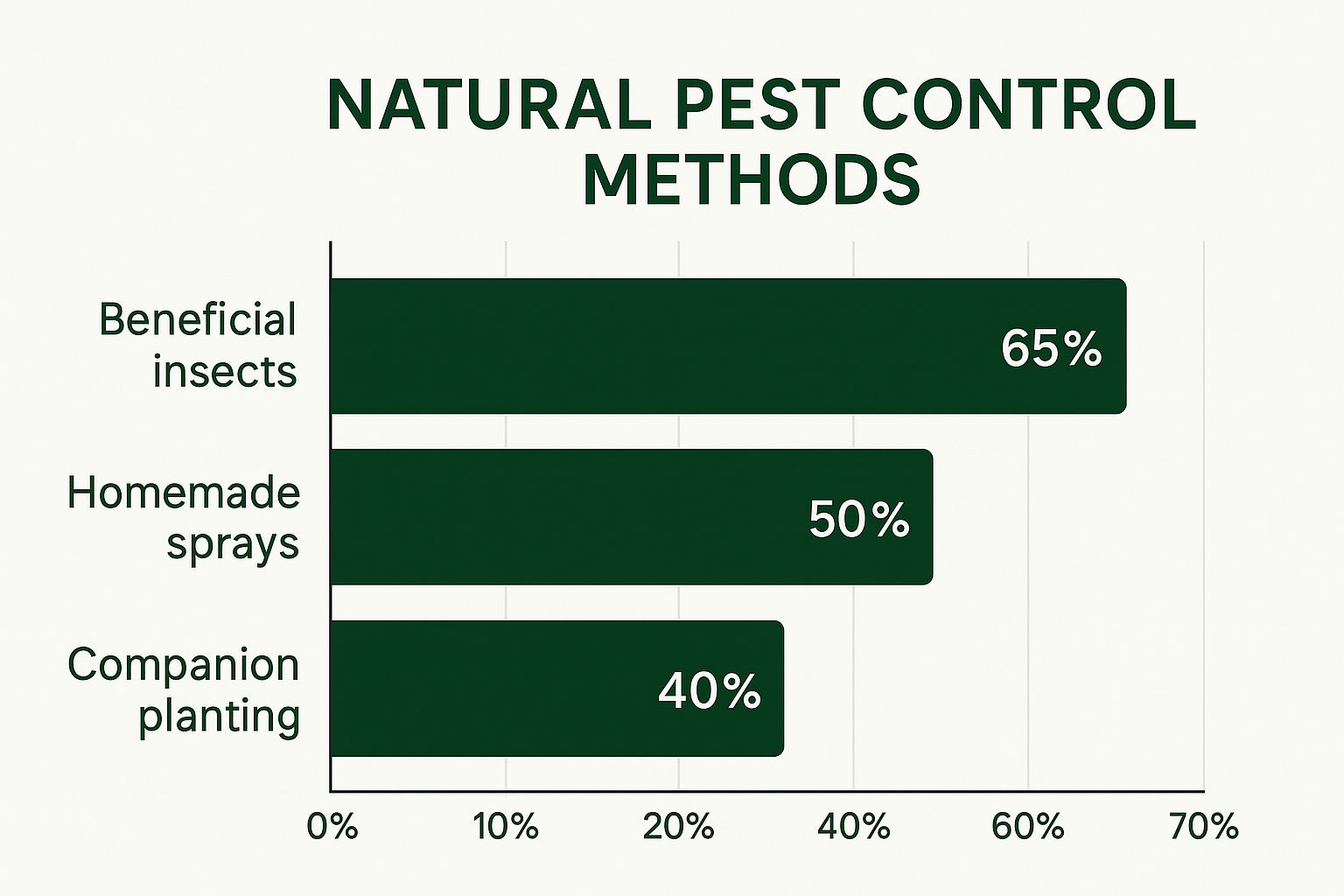
As you can see, bringing in beneficial insects often gives you the biggest bang for your buck, a great example of how working with nature is so effective. By correctly identifying the pest first, you can choose the most powerful and appropriate tool from your organic toolkit.
7 Physical Barriers That Stop Pests in Their Tracks
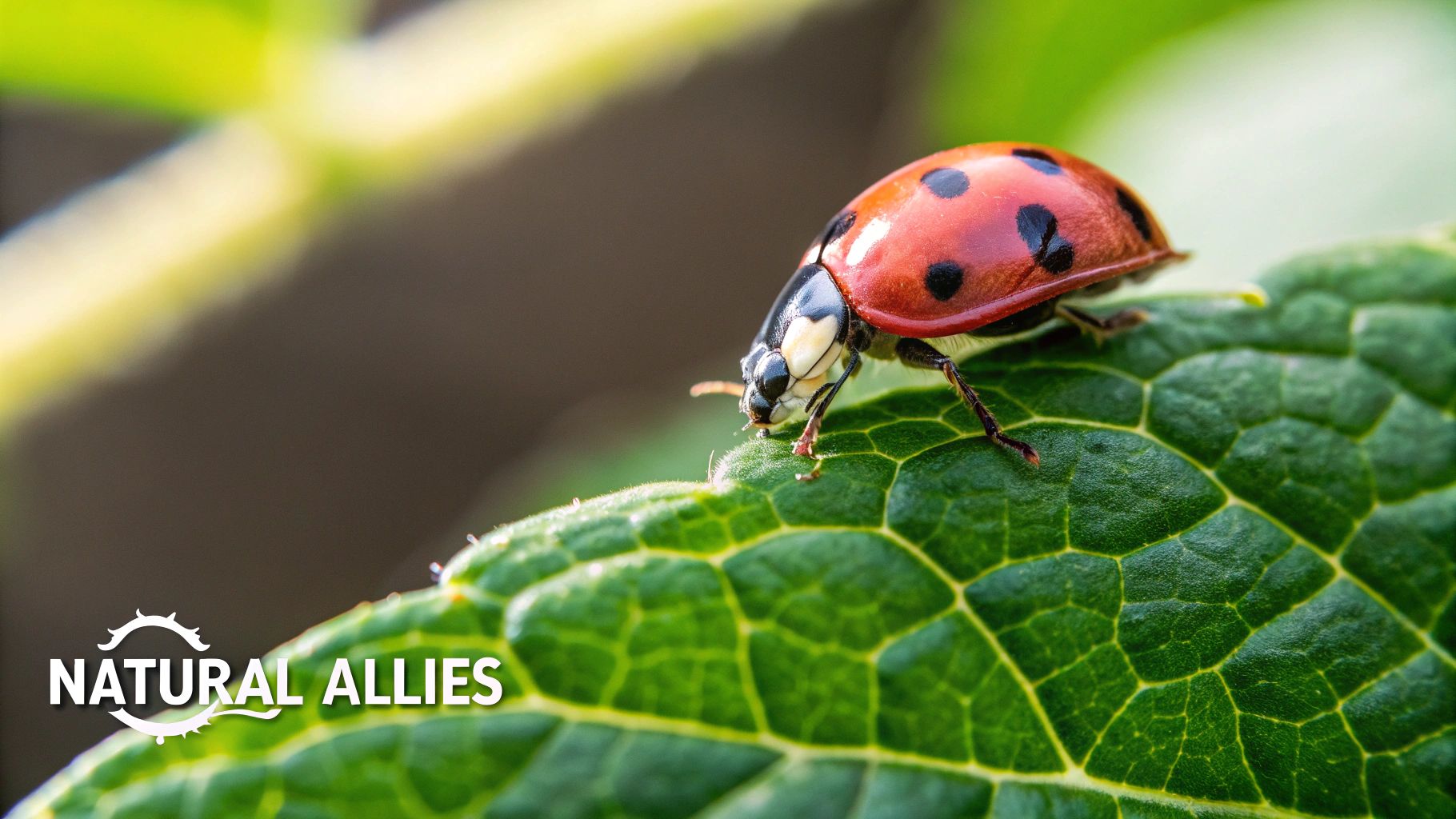
While bringing in good bugs and using sprays are great for dealing with pests you already have, the best defense is always a good offense. Physically blocking pests from ever reaching your plants is one of the most powerful things you can do. It’s a proactive approach that stops infestations before they even get a chance to start.
Think of it as setting up a friendly security system for your garden. These barriers work by creating an environment where pests simply can't get to the buffet you’ve laid out for them. It's a wonderfully straightforward method and completely chemical-free, making it perfect for an organic garden.
1. Use Floating Row Covers
Floating row covers are lightweight fabrics you drape right over your plants. They're amazing because they let sunlight, water, and air pass through but keep insects out. For protecting crops that are magnets for flying pests, they are a total game-changer.
For instance, if you're growing broccoli, cabbage, or kale, you know the heartbreak of finding your leaves full of holes from cabbage moths. By covering your brassicas with a row cover the moment you plant them, you completely deny the moth a place to lay its eggs. It’s an almost foolproof way to get a picture-perfect harvest.
2. Deploy Copper Tape
Slugs and snails are notorious for their slimy trails and their love for tender seedlings and hosta leaves. A surprisingly effective and fascinating way to stop them is with copper tape.
When a slug or snail tries to cross a strip of copper, its slime trail creates a tiny electrical charge that gives it an unpleasant jolt, causing it to turn back. Just apply the self-adhesive tape around the rims of your pots, containers, or along the edges of your raised garden beds. It creates a simple yet impassable fortress for these slimy critters.
Pro Tip: Keep your copper tape clean. Dirt and debris can form a bridge for slugs to cross without getting zapped. A quick wipe-down after watering will keep it working effectively all season long.
3. Apply Diatomaceous Earth
Diatomaceous Earth (DE) is a fine powder made from the fossilized remains of tiny aquatic organisms called diatoms. To us, it feels like soft dust. But for soft-bodied insects like slugs, aphids, and earwigs, it’s like crawling over a field of microscopic glass shards.
DE works by scratching the insect's waxy outer layer, which causes it to dehydrate and die. For this natural pest control to be effective, it must be dry. Sprinkle a thin layer on the soil around the base of vulnerable plants. Just remember to reapply it after it rains, as moisture makes it ineffective.
4. Install Netting and Mesh
Sometimes your biggest garden headaches aren't insects at all. Birds love juicy berries as much as we do, and squirrels can make off with your prized tomatoes. Don't worry, physical barriers work on them, too.
Draping fine-mesh bird netting over your blueberry bushes or fruit trees can be the difference between a harvest and a disappointment. For the dreaded squash vine borer, you can wrap the base of the plant stems with strips of nylon stockings or even aluminum foil. This simple trick prevents the moth from laying its eggs right at the soil line.
5. Hand-Pick Large Pests
This method is exactly what it sounds like, but don't underestimate how effective it can be. It's strangely satisfying and incredibly precise. For bigger, easy-to-spot pests like tomato hornworms or Japanese beetles, hand-picking is the most direct solution there is.
- Grab a pair of garden gloves and a bucket of soapy water.
- Head out in the morning or evening when pests are most active.
- Pluck them off your plants and drop them into the bucket.
It's a daily task that might only take a few minutes but can prevent a huge amount of damage, especially on treasured plants like your tomatoes and roses.
6. Use a Sharp Water Spray
For smaller pests like aphids and spider mites that cluster on new growth, sometimes all you need is a good blast of water. Use a hose with an adjustable nozzle to deliver a sharp, strong spray to the affected areas. Make sure you hit the undersides of leaves—that's where they love to hide.
This physical action simply knocks the pests off the plant. Many are too small and weak to find their way back. This is a fantastic first response because it's free, completely non-toxic, and you can do it as often as needed without harming your plants.
7. Create Sticky Traps
Sticky traps are pieces of cardboard or plastic coated with a sticky substance that catches insects when they land. They're especially useful for keeping an eye on and controlling flying pests like whiteflies, fungus gnats, and aphids in greenhouses or near houseplants.
You can buy them ready-made or easily create your own with some yellow cardstock and a thin layer of petroleum jelly. The color yellow is highly attractive to many common garden pests. While they won't solve a massive infestation on their own, they are an excellent tool for knocking down pest numbers and—more importantly—alerting you to a problem early on.
4 Powerful DIY Sprays You Can Make From Your Kitchen Pantry
While covering your plants is a great preventative step, sometimes pests show up anyway. When that happens, you don't always need to run to the garden center. A quick look in your kitchen pantry might be all you need to mix up a powerful, safe, and effective spray.
Making your own sprays is a cornerstone of natural gardening. You know exactly what’s going on your plants, which means your harvest stays clean, healthy, and completely chemical-free.
1. The All-Rounder: Neem Oil Spray
If there's one thing every organic gardener should have on hand, it's neem oil. This isn't a harsh, instant-kill poison. Instead, it works in a much smarter way by messing with the life cycle of pests like aphids, mealybugs, and spider mites. It stops them from feeding and growing, and as a bonus, it can even help with fungal problems like powdery mildew.
How to Mix It:
- Get a spray bottle and combine 1 teaspoon of high-quality, cold-pressed neem oil with about 1/2 teaspoon of a mild liquid soap, like Castile. The soap is crucial—it acts as an emulsifier, letting the oil and water actually mix.
- Add 1 quart (that's 4 cups) of warm water and shake it like you mean it.
- Spray your plants all over, paying special attention to the undersides of leaves. That's where the troublemakers love to hide.
A quick but important tip: always apply neem oil in the very early morning or late in the evening. Spraying it in the heat of the day or in direct sun can burn the leaves. You’ll want to reapply it every 7-14 days, or after it rains.
2. The Quick Fix: Simple Soap Spray
When you walk out to your garden and find a cluster of aphids on your kale or roses, this is your first line of defense. A simple soap spray is incredibly effective against soft-bodied insects. It works by dissolving their protective outer layer, which quickly causes them to dehydrate.
This is my go-to for aphids, thrips, and whiteflies because it's so easy to whip up in a pinch.
You don't need a heavy-duty detergent for this. In fact, harsh detergents can damage your plants. A gentle, pure soap—like an unscented Castile soap—is all you need. It’s tough on pests but easy on your plants.
How to Mix It:
- Stir 1 to 2 teaspoons of liquid Castile soap into 1 quart (4 cups) of water.
- Pour it into your sprayer and give it a gentle shake.
- It's always a good idea to test your mix on a single leaf first. Wait a day to make sure there's no damage before you spray the whole plant.
- If everything looks good, spray the affected areas, and don't forget those leaf undersides! Just like with neem, avoid spraying on hot, sunny days.
3. The "Stay Away" Scent: Potent Garlic and Chili Repellent
This next one isn't designed to kill pests on contact. Instead, it makes your plants taste and smell absolutely awful to them. It’s a fantastic repellent that convinces a wide range of chewing pests—from caterpillars to the rabbits eyeing your lettuce—to find lunch somewhere else. The combination of pungent garlic and spicy chili is just too much for them.
If you want to dive deeper into these kinds of recipes, our guide on homemade garden pest repellents has plenty of other ideas to try.
How to Mix It:
- Start by mincing or blending 1 whole bulb of garlic and 1-2 hot chili peppers (cayenne or even habaneros work great). Add just a splash of water to help form a paste.
- Add this paste to 1 quart of water and let it sit overnight to infuse.
- The next day, strain the liquid through cheesecloth or a fine-mesh sieve. You want to remove all the solid bits so they don't clog your sprayer.
- Before you spray, add a small squirt of liquid soap. This will help the repellent stick to the leaves.
4. The Seedling Protector: Gentle Chamomile Tea
This last recipe is less of a pest spray and more of a gentle guardian, especially for your delicate seedlings. Chamomile has natural antifungal properties that are perfect for preventing "damping off"—a common fungal disease that can wipe out young plants just as they're getting started.
How to Mix It:
- Brew a strong batch of chamomile tea. Use 2 chamomile tea bags or a handful of dried flowers in 2 cups of hot water. Let it steep for a few hours, or until it’s completely cool.
- Remove the tea bags and dilute the strong tea with another 2 cups of water, then pour it into a spray bottle.
- Lightly mist the soil surface around your seedlings every few days. It's a mild, safe way to keep fungus away from your fragile baby plants and give them a healthy start.
4 Beneficial Insects to Recruit for Your Garden's Army
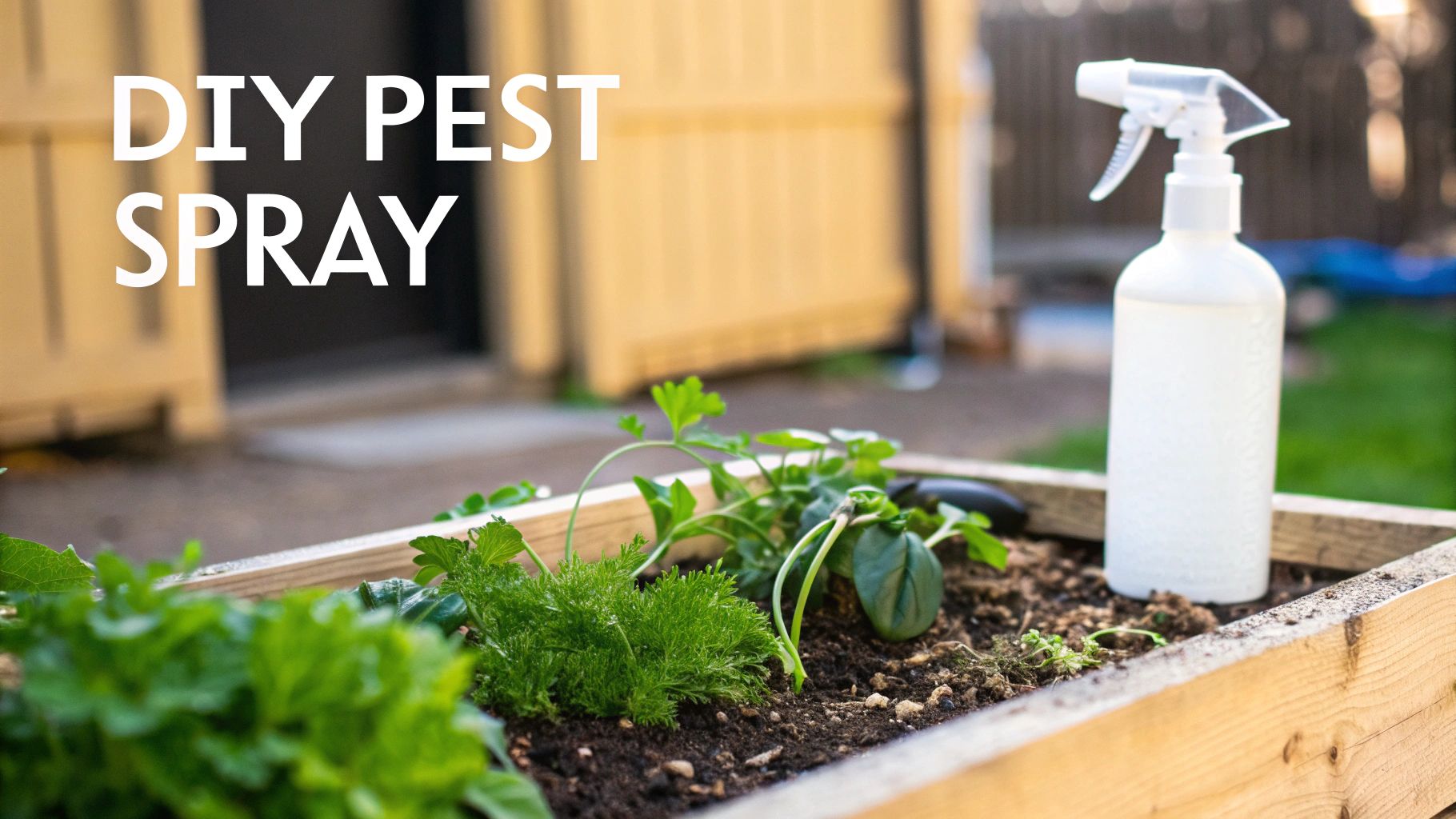
Fighting garden pests can feel like a lonely, uphill battle. So why go it alone? The smartest approach is to recruit a specialized team of allies to handle security for you. This is the whole idea behind biological pest control—turning your garden into a self-regulating ecosystem by inviting nature's predators to move in.
Instead of constantly reacting to the next infestation, you build a habitat that supports a permanent, on-site defense force. When you have a thriving population of these helpful critters, pest problems often take care of themselves before you even know they've started. It's a truly powerful and sustainable way to manage pests.
This isn't just a backyard gardening trick; it's a massive global shift. The market for natural enemy pest control is expected to jump from USD 19.2 billion to USD 32.8 billion between 2025 and 2035. This incredible growth shows just how seriously farmers and gardeners are taking biological allies like predatory insects. You can read more about this sustainable shift in a report from Future Market Insights.
To build this army, you first need to know who to recruit. While hundreds of insects can lend a hand, these four are absolute powerhouses in the average garden. Let’s get to know your most valuable allies.
- Ladybugs (Coccinellidae): They're the poster child for beneficial insects for a reason. A single ladybug can chow down on up to 5,000 aphids in its lifetime, making them voracious predators of soft-bodied pests.
- Lacewings (Chrysopidae): As larvae, these guys are known as "aphid lions," and they are ferocious. They don't just eat aphids; their diet includes mites, thrips, whiteflies, and even tiny caterpillars.
- Spiders (Araneae): I know they can make some gardeners jump, but spiders are phenomenal pest managers. Orb-weavers set up nets to catch flying pests, while ground hunters like wolf and jumping spiders actively seek out a wide range of insects.
- Parasitic Wasps (multiple families): Don't let the name scare you. These are tiny, non-stinging wasps that act like specialists. They lay their eggs inside pests like tomato hornworms and cabbage worms. The wasp larvae then consume the host from the inside—it's grim, but it's also incredibly effective.
When you see a spider web glistening with morning dew in your garden, your first instinct might be to clear it away. Don't. That web is a perfectly engineered pest trap, and that spider is one of your most dedicated employees, working 24/7 to protect your plants.
3 Ways to Attract and Keep Your Beneficial Allies
You can't just hope these helpers will show up; you need to roll out the welcome mat. A welcoming habitat is the absolute key to not only attracting but also keeping a healthy population of beneficials.
It all boils down to providing three essential things: food, water, and shelter.
1. Provide a Diverse Buffet
Adult beneficial insects need more than just pests to eat. In fact, many rely on nectar and pollen as their main food source. By planting a variety of flowers with different shapes and bloom times, you ensure there's always something on the menu.
- Umbellifers: Think plants with small, clustered flowers. Things like dill, fennel, cilantro, and yarrow are magnets for ladybugs and parasitic wasps.
- Composites: Flowers from the aster family, like cosmos, sunflowers, and zinnias, have wide-open faces that offer easy-access pollen for lacewings and hoverflies.
- Herbs: Letting some of your herbs like thyme, oregano, and mint go to flower provides a rich source of nectar for countless good bugs.
2. Offer a Source of Water
Insects get thirsty, too, especially during those hot, dry summer days. A simple, shallow dish of water with a few pebbles or marbles in it can be a literal lifesaver. The stones give them a safe place to land and sip without the risk of drowning.
3. Create Shelter and Overwintering Spots
Your insect army needs a safe place to hide from its own predators and to ride out the winter. You can easily help them by:
- Leaving a small, "untidy" patch in your garden with some leaf litter and hollow stems.
- Planting perennial bunch grasses or other dense groundcovers.
- Holding back on aggressive fall cleanup. Many beneficials spend the winter as pupae tucked away in garden debris.
When you start actively creating this kind of inviting environment, your garden transforms. It's no longer just a collection of plants—it becomes a dynamic, living ecosystem where nature's own defenders keep the peace.
2 Ways to Design a Pest-Resistant Garden with Companion Planting
Think of your garden as a team, where certain plants actively look out for their neighbors. That’s the simple idea behind companion planting, a time-tested strategy for natural pest control that’s much more than just old garden folklore. It’s all about creating smart partnerships that make your garden a far less inviting place for pests to settle in.
This isn't just about sticking a marigold next to a tomato plant and hoping for the best. It's a thoughtful approach to designing a diverse and interactive plant community. For instance, the strong, pungent scent of basil planted near tomatoes can actually help mask their aroma, throwing off pesky tomato hornworms. In the same way, planting rosemary alongside your carrots can help hide their smell from the destructive carrot rust fly.
This long-term, sustainable strategy is gaining serious traction. The global market for garden pesticides was valued at USD 8.58 billion in 2023 and is expected to climb, with a notable shift toward biological and natural methods. As more gardeners seek out eco-friendly solutions, this trend is only getting stronger. You can discover more insights about this market trend on straitsresearch.com.
1. Use Plants as Repellents and Decoys
The real magic of companion planting is in understanding how different plants interact. Some plants are natural repellents, using their strong scents to drive pests away. Others act as decoys, luring pests away from your more valuable crops. It’s a brilliant way to build a self-sufficient, resilient garden ecosystem.
Nasturtiums are a classic example of a decoy plant. Aphids find these beautiful, edible flowers absolutely irresistible. If you plant a border of nasturtiums around your vegetable patch, you can draw the aphids to them, which effectively protects your beans, broccoli, and other prized veggies. This technique is known as trap cropping.
Here are a few powerful combinations I’ve had success with:
- Borage for Cabbage Worms: Cabbage worms hate the fuzzy leaves of the borage plant. Interplanting it with your brassicas (like cabbage and kale) offers surprisingly good protection.
- Petunias for Asparagus Beetles: A few vibrant petunias can act as a powerful repellent for the asparagus beetle, a pest that can make quick work of a tender asparagus patch.
- Catnip for Flea Beetles: If you've ever seen that "shotgun blast" pattern of tiny holes on your eggplant or potato leaves, you’ve met the flea beetle. Planting catnip nearby can really help keep them away.
Think of your garden design as a strategic puzzle. Every plant you choose can serve multiple purposes—it’s not just about food or flowers, but about contributing to the health and defense of the entire system.
2. Create a Garden That Works in Harmony
Truly effective companion planting goes beyond simple one-to-one pairings. The real goal is to weave a diverse tapestry of plants that confuses pests and welcomes beneficial insects. A monoculture—a big block of just one type of plant—is basically a giant "All You Can Eat" buffet for pests.
By mixing in herbs, flowers, and a variety of vegetables, you break up that monoculture. This creates a beautiful, polyculture garden that is much harder for pests to navigate. For those looking to dive deeper into garden layouts, our guide on which vegetable seeds go well together has plenty of practical pairing ideas.
When you design your garden with these principles from the start, you're not just planting vegetables; you're building a beautiful, productive, and self-defending space that thrives naturally.
4 Common Questions About Natural Pest Control
When you start moving away from chemical sprays, a lot of practical questions pop up. It's easy to read about natural methods, but putting them into practice when you see your kale covered in aphids is a whole different story. Let's walk through some of the most common things gardeners wonder about when they go organic.
Getting these answers straight can be the difference between feeling confident in your garden and getting completely overwhelmed.
1. How Quickly Do Natural Sprays Work?
If you're used to chemical pesticides, you're used to seeing pests drop dead almost instantly. Natural sprays work on a different timeline, so a little patience goes a long way. An insecticidal soap spray, for example, can start taking out soft-bodied bugs like aphids within a few hours, but it’s not an immediate knockdown.
Neem oil is even more of a slow burn. It's not a contact killer at all. Instead, it messes with the pest's biology, acting as an anti-feedant and disrupting their life cycle so they can't reproduce. You might not see a huge die-off for several days, but trust me, it’s working behind the scenes. The key is to keep an eye on things and let the process unfold.
Natural pest control is less like an emergency room visit and more like a long-term wellness plan. The goal is to gradually restore balance, not just to perform a quick, harsh intervention.
2. Is It Safe to Use Neem Oil Near Harvest Time?
This is a great question, and one I get all the time. Yes, it's generally safe to use neem oil on your veggies, but a little common sense is in order. I always recommend stopping all sprays about a week before you plan to harvest. This gives the plant more than enough time to absorb any residue so it won't impact the taste of your hard-earned produce.
And of course, always wash your fruits and vegetables thoroughly before eating them. That’s just good practice, no matter what you have or haven't sprayed. A quick rinse removes any lingering traces and gets your food ready for the kitchen.
3. What if a Pest Problem Feels Overwhelming?
First off, take a deep breath. Even the most seasoned gardeners get hit with a pest explosion now and then. When an infestation looks really bad, you need to hit it from multiple angles.
- Prune Heavily: Don't be shy. Cut off the most infested leaves and stems. This instantly gets rid of a huge chunk of the pest population.
- Combine Methods: Start with a strong jet of water from the hose to physically blast pests off the plant. Follow that up with a thorough application of insecticidal soap or neem oil.
- Call in Reinforcements: Think about releasing beneficial insects. Ladybugs or lacewings can be fantastic allies in targeting the specific pest you're dealing with.
Sometimes, a plant is just too far gone. If it's covered and weak, the smartest move might be to pull it out and dispose of it to protect the rest of your garden. For a deeper dive, our guide on how to get rid of plant pests has more advanced troubleshooting ideas.
4. How Often Should I Reapply Homemade Solutions?
Most homemade and organic sprays just don't have the staying power of synthetics. They break down in sunlight and wash off easily with rain or even a heavy watering.
As a rule of thumb, plan to reapply your sprays every 5 to 7 days when you're actively battling an outbreak. Once you've got the pests under control, you can switch to a preventative schedule, spraying every 10 to 14 days. And a pro tip: always spray in the cool of the early morning or late evening to avoid the risk of scorching your plants' leaves in the sun.
At Homegrown Garden, we believe that a healthy garden starts with the right knowledge and high-quality seeds. Explore our curated collection of heirloom seeds, starter kits, and organic gardening supplies to build your own thriving, resilient garden ecosystem. Visit us at https://www.homegrown-garden.com to get started today.



